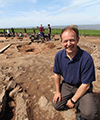July
Dig reveals more about Maryport Roman Temples site

A team of archaeologists and volunteers led by Newcastle University’s Professor Ian Haynes and site director Tony Wilmott have been uncovering more secrets of the Maryport Roman Temples.
This is the fourth season of work commissioned by the Senhouse Museum Trust. The aim of the project is to find out more about the complex religious landscape of the Maryport site, next to the Senhouse Roman Museum, where there is a Roman fort and large settlement.
Last year the team re-excavated a rectangular classical temple originally uncovered in the 1880s and were able to recover more detailed information to allow a reconstruction drawing to be made. This year they have concentrated on the area surrounding this and they have re-examined a large stone circular structure next to the rectangular temple. In front of the temple they have found evidence for an open gathering area and the foundations for a large monument.
“The rectangular temple is the most north westerly classical temple in the Roman world to be discovered so far and dates from the 2nd century,” said Professor Haynes (pictured).
“Both this and the circular structure were originally located by local bank manager and amateur archaeologist Joseph Robinson. Photographs and other documents from the 1880s indicate that only part of this area was excavated and much remains to be discovered.
“From this year’s excavation we have evidence for an open area in front of the classical temple and the foundations of a substantial monument, which probably supported a free standing column. A further important discovery was the location of an entrance to the circular structure, indicating that it shared the same alignment as the rectangular temple.
“The finds also show this area, which is to the east of the settlement and north east of the fort, was used in a different way to the main settlement area. The contrast with domestic areas is pronounced and reflects the ritual character of this area.
“We would still like to find out more about exactly where and how the altars found in the 1870s further east of this site were originally displayed here when they were dedicated to the Roman god Jupiter each year by commanders of the fort.
“We have established that when they were ‘buried’ they were actually being reused in the foundations for a large timber building in the 4th century, but where were they before then? We’re aiming to find more information on this when we return to work here next summer.”
The 23 Maryport Roman altars - one excavated by the team in 2012 - form an important part of the collection at the Senhouse Roman Museum. They are the largest group of Roman military altar stones and inscriptions from any single find in Britain.
The information the altars provide is of international importance for the study of the Roman army and its religious practices. The career histories of some of the fort commanders can be established from the inscriptions as they moved from posting to posting across the empire.
Rachel Newman of the Senhouse Museum Trust said: “Each year of the Temples project, with the fantastic support of volunteers and archaeology students on the dig, we’ve been able to build a more detailed picture of this part of the site.
“The digs have inspired more local people and school groups to visit the Senhouse Roman Museum and site too to find out about their amazing heritage.”
Over the six weeks of the dig the team has included sixth form students from Workington, Allonby and Newcastle, working alongside adult volunteers and archaeology students from around the UK and from the US, Canada, the Netherlands, Albania and France.
Nigel Mills, heritage advisor to the Hadrian’s Wall Trust said: “The Temples project and the Settlement project at Maryport complement each other and show there is much potential to attract more visitors to the Roman sites along the Cumbrian coast. These sites are part of the Frontiers of the Roman Empire World Heritage Site, along with Hadrian’s Wall itself.
“Maryport was an important part of the coastal defences of Rome’s north west frontier for over 300 years. Roman citizens from across the Empire came here to make a living supplying soldiers in the fort and elsewhere across the frontier. The temple is evidence of close connections across the Empire. Roman citizens would have felt at home here in Maryport.”
published on: 25 July 2014
